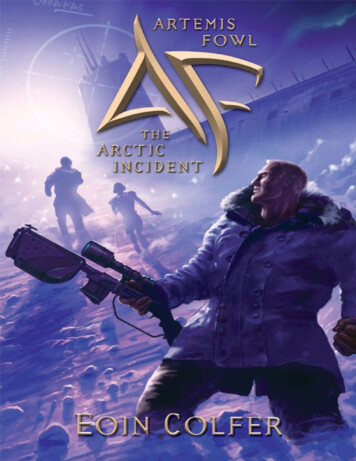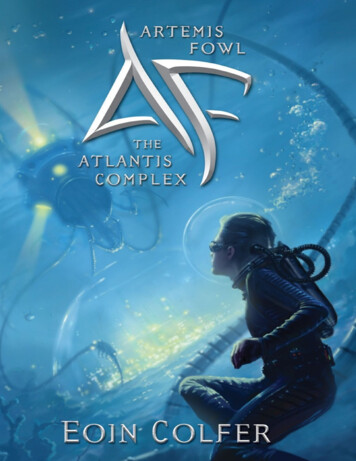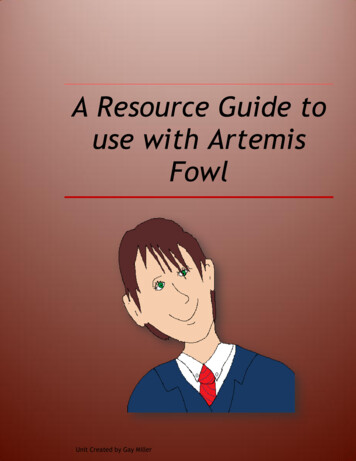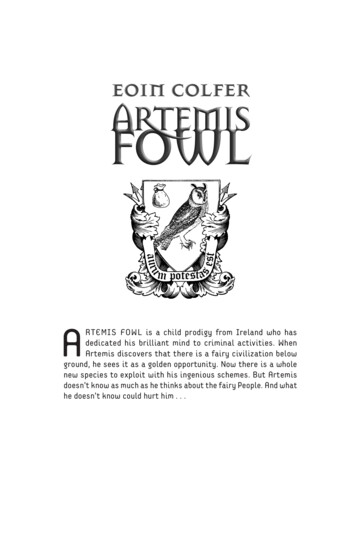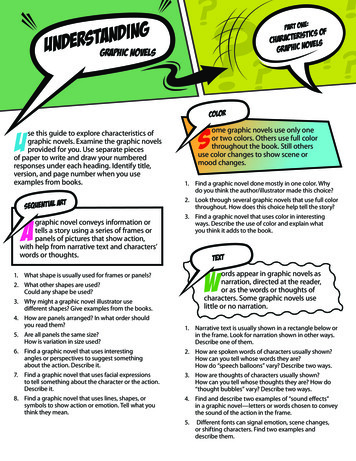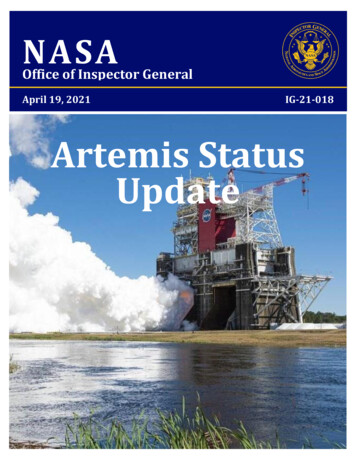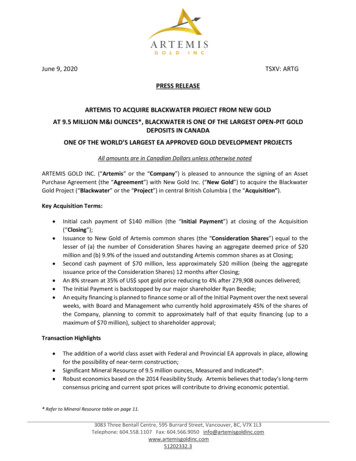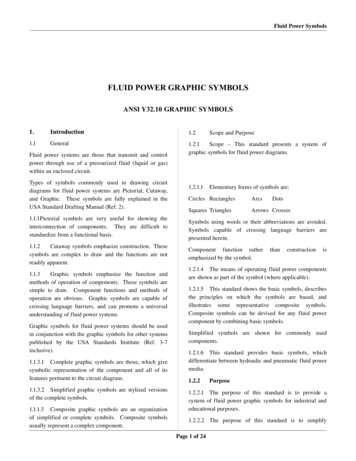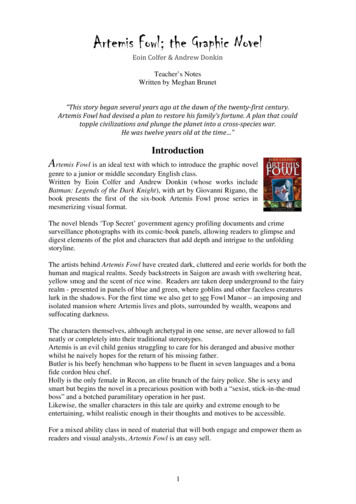
Transcription
Artemis Fowl; the Graphic NovelEoin Colfer & Andrew DonkinTeacher’s NotesWritten by Meghan Brunet“This story began several years ago at the dawn of the twenty first century.Artemis Fowl had devised a plan to restore his family’s fortune. A plan that couldtopple civilizations and plunge the planet into a cross species war.He was twelve years old at the time ”IntroductionArtemis Fowl is an ideal text with which to introduce the graphic novelgenre to a junior or middle secondary English class.Written by Eoin Colfer and Andrew Donkin (whose works includeBatman: Legends of the Dark Knight), with art by Giovanni Rigano, thebook presents the first of the six-book Artemis Fowl prose series inmesmerizing visual format.The novel blends ‘Top Secret’ government agency profiling documents and crimesurveillance photographs with its comic-book panels, allowing readers to glimpse anddigest elements of the plot and characters that add depth and intrigue to the unfoldingstoryline.The artists behind Artemis Fowl have created dark, cluttered and eerie worlds for both thehuman and magical realms. Seedy backstreets in Saigon are awash with sweltering heat,yellow smog and the scent of rice wine. Readers are taken deep underground to the fairyrealm - presented in panels of blue and green, where goblins and other faceless creatureslurk in the shadows. For the first time we also get to see Fowl Manor – an imposing andisolated mansion where Artemis lives and plots, surrounded by wealth, weapons andsuffocating darkness.The characters themselves, although archetypal in one sense, are never allowed to fallneatly or completely into their traditional stereotypes.Artemis is an evil child genius struggling to care for his deranged and abusive motherwhilst he naively hopes for the return of his missing father.Butler is his beefy henchman who happens to be fluent in seven languages and a bonafide cordon bleu chef.Holly is the only female in Recon, an elite branch of the fairy police. She is sexy andsmart but begins the novel in a precarious position with both a “sexist, stick-in-the-mudboss” and a botched paramilitary operation in her past.Likewise, the smaller characters in this tale are quirky and extreme enough to beentertaining, whilst realistic enough in their thoughts and motives to be accessible.For a mixed ability class in need of material that will both engage and empower them asreaders and visual analysts, Artemis Fowl is an easy sell.1
Plot SynopsisThe opening paragraphs are written on yellowed parchment, as though a wrinkled andbespectacled psychiatrist has attempted to observe and record exactly what it is that is sodifferent about young Artemis Fowl.Artemis is described with bewilderment as a “child prodigy” who “delights in notspeaking” and “dedicates himself wholly to criminal activities”.From there the first few illustrated panels begin to tell the story of Fowl’s latest villainy.A satellite picture of the universe; safe for now. A pale figure hunched over reams of databy the light of a single lamp. A birds-eye view of Ho Chi Minh City, where a twelve yearold boy in a dark suit and a giant bodyguard trawl the streets in search of a drunkenfortune-teller Artemis has, after months of research, learnt that there exists a fabled book in which allthe secrets of the fairy race are recorded; their magic, their wealth, their laws and theirweaknesses. The human intelligent enough to translate the Gnommish script would findhimself with “an entirely new species to exploit”.Using his brains, Butler’s brawn and the boundless familyfortune, Artemis locates and translates the book. The latter taskis no mean feat. Computer screens blaring “NEGATIVE”sprawl across the pages where other panels explore the realworld Artemis lives in: A dark, eerie mansion too vast andempty for one little boy and his delusional mother.Artemis finally solves the puzzle and states with no emotionwhatsoever that fairies are now under his command, bound “tohelp me restore the financial fortune and the criminal reputationof the Fowl Family”. if only he can find one.It is here we meet Holly, the young female member of the fairy special police, working tomaintain order and secrecy in the last underground safe haven for all creatures like her.She is smart and sassy, and desperate to prove herself to her chauvinist pig of a boss. Butshe is weak when she takes on a risky mission that will take her to the surface world,having not yet renewed her magic with the yearly ritual.After a bungled troll-retrieval operation in the human-world, Holly is left vulnerable andvisible. As she limps her way to the ancient ritual site, Artemis, armed with theknowledge of all her magic tricks, quickly captures her.With a valuable member of the fairy underworld as his prisoner, Artemis now holds thefairy world to ransom. His demand is one tonne of fairy gold in exchange for one hostage.The authorities are forced to obey his demands as in one incident after another Artemisshows that he is not a ‘man’ to be toyed with.Having been given the gold Artemis becomes aware that his enemies have planned adouble-cross, sacrificing their own agent in order to wipe out all human occupants ofFowl Manor with their most powerful weapon – the Bio-Bomb.We hold our breath as Artemis asks his companions to trust him, and then administersthem all and himself, a powerful sedative.We should not be surprised when the next few pages reveal a genius plot that has onceagain, managed to foil Artemis’ enemies and ensure that Artemis ends up with exactlywhat he planned from page one.2
Chapter by Chapter discussionThe Introduction is one simple double-spread. One page of prose and one page of panels.Questions:1. How does the author create intrigue in the first description of Artemis?2. How has the artist in the second panel communicated the idea that Artemis is arecluse?In Chapter One we find Artemis and Butler in the middle of a cluttered and chaotic HoChi Minh city, liaising with an opportunistic snitch who has information about the bookthey seek. This leads them to a deserted back-alley slum, where an ancient fairy offersfortunes for rice wine. Artemis tricks her into drinking Holy Water and she is forced totrade her book for the viral antidote, which Artemis then photographs and flies home.Questions:1. Discuss the colours and details used to create a specific sense of place in Saigon.2. Discuss the presentation of the waiter-snitch. How do we know he is a shadycharacter by his physical appearance?3. How does Artemis speak and why is this unusual for a twelve-year old boy? Whymight he possess this kind of vocabulary and tone?4. How is the fairy world first represented to us? Discuss the wider symbolism of thedrunken, hermit fairy.In Chapter Two we learn more about Artemis’sad personal life. He spends hours locked away inhis study, trying to decode the Gnommish scriptof the book. We learn that Butler lives with him,as does Butler’s younger sister Juliet. Upstairs,locked in self-imposed quarantine, is Artemis’deranged Mother, driven insane by the mysteriousdisappearance of her husband years ago.Artemis finally notices the similarities between the fairy script and the Egyptianhieroglyphs on an old family heirloom, and the secrets of the book are unlocked.Questions:1. How is Fowl Manor a visual indication of the way Artemis has been brought up?2. In what scenes do we as the reader feel sympathy for Artemis? How has theauthor prevented Artemis from becoming the stereotypical villain?3. Discuss the symbolism of the colours and lighting presented in the interior scenesof Fowl Manor?4. How would you describe the relationships between Butler and his sister, andbetween them and Artemis?5. What allusions are made to Artemis’ Father in this chapter? What is thesignificance of all the blue tones used in this scene?In Chapter Three we meet Holly, getting ready for another day at Recon. She is givena tongue-lashing by her superiors for arriving one minute late, and then assigned to adangerous ‘locate and retrieve’ mission above ground, where a rogue troll is about toencounter human life. Unwilling to risk her job by admitting her magic is at a low ebb,Holly takes the mission and nearly dies when it goes horribly wrong. In shame sheslinks off to perform the ritual to renew her magic powers.3
Questions:1. How would you describe Holly’s personality from the first page alone? Justifyyour response with textual evidence.2. What is she haunted by, and how is colour used in the memory panels?3. On the second page Holly narrates that “since the humans began experimentingwith mineral drilling, more and more fairies have been driven into the depthand security of Haven City”. What wider meaning does this have regardinghumans and their relationship with the planet?4. What is interesting about the names used for various creatures in this other world?5. Discuss the physical appearance of Haven City, and Holly’s workplace. What erado you think this is set in? What does it suggest about the fairy species?In Chapter Four Artemis and Butler lie in wait for a fairy to come to the ritual placethey have read about in the Book. She struggles in vain, as Artemis is equipped with thefore-knowledge of all her spells and developed gadgets to defend against them.Questions:1. Discuss the visual presentation of the human world in the first page? How does itcontrast with the fairy world?2. How have the artists managed to communicate two concurrent plot-lines at thesame time, through the use of colour and panels and close-ups?3. How are internal thoughts presented in order to distinguish them from spokenconversation?In Chapter Five we find ourselves back at Reconheadquarters where Commanders Root and Foaley arealarmed at the feedback they have received from Holly’shelmet camera. Root comes to the surface to rescue hislost agent, who is now being held prisoner in the hull ofan abandoned merchant ship, with Juliet as her curiouswarden.Artemis, watching his prisoner on screens from the safetyof Fowl Manor, has a moment of self-doubt and guilt, butquickly recovers and deals swiftly with Commander Root who has attempted to enterthe ship.Questions:1. Discuss the setting of Dublin Docks and why it is appropriate as the preferredlocation of Artemis.2. What evidence is there in the text that Butler is not merely the mindless ‘brawn’in this operation?3. Discuss the persona of Commander Root. Does he remind you of any othertypical “big boss” figures in other novels or films?4. How is Artemis humanised briefly in this scene, and what image signifies hisdeparture from all emotions?5. How does Artemis relate to adults and why is this unusual?6. How are shadows and perspective used to portray evil just before the explosion?4
In Chapter Six the Recon team gather their resources, come to the surface and placeFowl Manor under siege.Questions:1. What emotions are stimulated by the scene in which Artemis’ mother fawnsover a stuffed effigy of her missing husband?2. What colours and setting have you come to associate with Artemis’ mother?Why might these colours have been selected?3. What evidence is there in this chapter that Artemis is still a little boy inside?4. How is Artemis’ power enhanced by the reactions other characters, such asFoaley, have to him?5. Discuss the different management styles of Artemis and Commander Root.6. How are the fairy Recon squad presented as a paramilitary group? What is theirhuman equivalent?7. How is the use of colours, angles, perspective and text font different in fightscenes? Discuss.8. What is Holly attempting to do in her cell that so puzzles Artemis, and what ishis and Butler’s response to her struggles?9. How is colour used to distinguish the outside of Fowl Manor from the inside?10. What is the symbolism of the fire in the negotiation scene between Root andArtemis?In Chapter Seven we meet Mulch, a low-life dwarf incarcerated for breaking andentering. Since he can dig at incredible speeds, expelling the rocks and dirt from hisrear-end, he has been released to dig into Fowl Manor from underneath. Using thetechnology given to him at Headquarters, and some forest-levelling flatulence, Mulchrescues Holly (although she is still bound to the Mansion) and in the following flurry ofransom exchanges, manages to escape.Questions:1. What parallels are drawn between thehuman world you are familiar with, andthe world of underground creatures inthe prison scene?2. How is a hierarchy suggested in the fairyworld, through the way various creaturespecies are drawn?3. How has colour been used to separatedifferent spheres of action (settings) inthis chapter?4. How is magic represented in art?5. Why can’t Holly leave the mansion afterbeing rescued?6. What evidence is there in the text thatArtemis is not always confident in hisplans?7. How does Mulch escape the authorities?In Chapter Eight Julius Root is replaced as Head of Operations, by a young, ambitiousupstart who believes unleashing a furious troll will solve the stalemate with Artemis.Holly tries to warn the humans of the troll approaching but it bursts into the house andunleashes hell. Butler is nearly killed, but Holly uses her magic to heal him and hemanages to find a way to bludgeon the troll into submission.5
Questions:1. How does this chapter deal with familiar human concepts such as corruption,ambition and division amongst the authorities?2. Why is the panel showing Artemis on the floor after being punched by Holly,repeated three times? Why does the lighting change in each? What is beingsuggested about his character?3. What do Holly’s actions in saving the humans from the troll reveal about hercharacter?4. How have the artists managed to capture and communicate the size and strengthof the troll?5. Discuss the use of onomatopoeia in this chapter.6. Discuss the colours, angles and perspectives used in the scene between Butlerand the troll. Why is Butler’s use of antique armour significant?7. Discuss the way in which our view of this troll completely changes in just onecomic panel. Find the panel and discuss why it has such impact.8. How is the passing of time communicated in the long blue panels after the trollis thrown from the manor?In Chapter Nine the fairies unleash their last result and most powerful weapon – theBio-Bomb. Its job is to obliterate all organic life-forms in the building whilst leavingthe structure and content intact. Artemis is given the gold but he mystifies his enemiesby letting Holly walk out with half of it. Inside the manor, as the Bio-Bomb is beingprepared, Artemis seeks the absolute trust of his companions and gives them all apowerful and instant sleeping potion. In quite a sensitive scene the three companionstoast to their collective risk, and the Bomb hits the mansion.The final pages unveil the deviously simple way in which Artemis managed to escapewith his friends, and the Recon officers return to the Underworld, struggling to swallowthe fact that they have been thoroughly beaten by a pubescent brat.Questions:1. What evidence is there that Artemis can appreciate the friendship of others?How does he demonstrate his friendship to Butler and Juliet throughout thischapter?2. Discuss another friendship that ends in this chapter, and explain why this was so.3. What object is used to symbolise unity and loyalty when Artemis and hiscompanions devise their final plan?4. What visual elements add drama and poignancy (sentiment) to this final scene?5. What is revealed by Artemis’ first word when he recovers from his stupor?6. Discuss the use of light in the last pages of this chapter.7. How has the author cleverly left us with a mixed impression of Artemis in thefinal page? Why might he have ended with a contradiction like this?6
Major CharactersHolly Short is the only female in Recon, the special division offairy police responsible for the secret retrieval of undergroundcreatures who stray to the human world.She represents the feisty female archetype, desperate to proveherself in an all-male world of “gangs” and “dirtbags” but alsodriven by her own macho lust for action “God I love this job”.She is haunted by a failed retrieval operation that occurred inHamburg, and has thus lain herself open for public criticism of eventhe smallest infractions “What time do you think this is Short!!”A typical youth, she has put off performing her magic-renewing ritual until it’s too late,and thus her capture by Artemis is inevitable when she comes to the surface.Holly nevertheless is smart, quick-thinking and compassionate – caring more for thepreservation of life (human and fairy) than for her official duties.Artemis Fowl Jnr is the central protagonist of the novel, and acharacter possibly already well-known by many of your students.His supreme intelligence at such a young age, and in particular hismoral misuse of these talents, have “puzzled the greatest medicalminds and sent them gibbering to their own hospitals”.He is a child prodigy of baffling extremes. He is a mathematicaland scientific genius, can translate ancient languages and possessesan unnerving knowledge of the human psyche. He effortlessly manages the family estateand his mentally ill mother – not to mention his own employees, international travelitinerary and plot for world domination.He is also however, something of a contradiction.He is both evil villain and child victim. Perhaps his eternal quest for wealth, power anddomination over others is merely compensating for a lack of family, love and youth.He feels moments of remorse (“I hadn’t expected our guest to appear quite so human”), misses his father terribly (“but there isn’t going to be any news of Mr Fowl”)and always protects his Butler’s life along with his own. He is also visibly affected by theverbal abuse his deranged mother throws at him, caught up in her own miserabledelusions. When at the end he spends his millions in ill-gotten fairy gold on a wish for hismother to be well again, we see the little boy he has been all along. “Her embrace iswarm and strong. I feel like a boy again”.Butler comes from a long line of men who have served the Fowlfamily. His occupation is also his real last name – “several eminentlinguists believe this is how the noun originated”. His skillsinclude SAS-level marksmanship, martial arts, emergencymedicine, fluency in several languages and cordon bleu cooking.He is more than just the “muscle” or the “henchman” of this storyhowever; his friendship with and unofficial guardianship ofArtemis is evident at many points in the novel. He is concerned for Artemis’ personalwellbeing “It’s after dawn sir why don’t you have a break?” as much as he is for the7
mission he is assigned to do. Artemis trusts him completely “Why should I flinch? Butleralways intervenes” and makes it clear that Butler commits crimes only as part of hisloyalty to the Fowls “Butler is a man of great honour. He does not find kidnappinginnocents easy”. Butler also has a younger sister, Juliet, who lives in Fowl Manor withhim and Artemis. He is thus also involved in various situations where we see he is caring,devoted and aggressively protective of both his own family and his adopted one.Julius (Commander) Root is the head of LEPrecon – the specialbranch of fairy police that are in charge of retrieving all manner ofdangerous and criminal creatures who have strayed to the humanrealm and risk making contact.He is a career-cop, notoriously aggressive, pushy and disrespectfulof “any authority other than his own”. He seems to be theotherworldly parallel for such typically wound-up bosses as we seein Superhero flicks, office TV shows and police dramas. “Theycall him “Beetroot”. There’s an official betting pool running on how long it’ll be beforehis heart explodes.”Again however, he is not allowed to completely satisfy the obnoxious-boss stereotype.He explains his unfair treatment of Holly as proof of his respect for her “there are a lot ofhopes resting on you” and more than once risks his own life and career to save the livesof his staff, “for a job like this, we need our very best”.ThemesGriefArtemis’ actions cannot be separated from his deplorable situation as a child with noparents. He grieves for his Father, Artemis Fowl Snr, who has been missing presumeddead since his cargo ship was sunk by the Russian Mafia in the Bay of Kola. In his studyArtemis has installed an entire wall of televisions, permanently tuned to every majorinternational news channel, so that if ever a trace of his father is found, he will knowimmediately. These televisions are never turned off, and are a physical reminder ofArtemis’ loneliness, hope and obsession.Artemis also grieves for his mother – alive but not mentally well. Since the disappearanceof her husband she has been driven insane by the lack of knowledge or closure. She locksherself in her chambers, where she lives in a delusional fantasy that her husband is aliveand sharing her bedroom. Artemis is called on frequently to bring her food or some othercomfort, where he is faced with a mother who not only does not recognize her only son,but verbally abuses him at the slightest provocation.-What visual evidence is there that Artemis is in a state of permanent grieving for hisFather?What is the difference between the pain Artemis feels in relation to his father and hismother?To what extent might Artemis’ grief be influencing his actions?How are colours and setting used to communicate the disturbing world of Mrs Fowl?If Artemis’ parents were alive and well, how would you feel about his actions?8
EvilThis is a very interesting theme in the novel – due to its ambiguity. Artemis is clearlycapable of assault and abduction if not murder, and rarely displays remorse or secondthoughts about any of his violent and deceptive actions.He is an accomplished liar at the age of twelve, capable of manipulating adults on somany levels that not even their criminal psychologists and profilers are safe from hiscalculated deceptions.On the other hand, how can he truly be evil if he is just a child? Are his violent,domineering words the bluff of a young man scared to use aggression? We might notethat it is Butler who performs the more heinous aspects of Artemis’ plans, and thatArtemis is never seen firing a gun or delivering a blow. In many cases his clever plans aredevised so carefully to avoid physical violence, and there are moments when Artemis isvisibly shaken by aggression (verbal and physical) when it is directed at him.-What is the difference between evil and opportunism?Why is intelligence so effective for evil?Is Artemis truly evil?Can children be evil?What might the author be saying here about the effect of poor parenting (or lack of)on the behaviour of young teens?Artemis uses the gold he has demanded from the fairies in ransom, to purchase a wishfor his mother to be well again. Does this motive justify the means by which heacquired the gold? Does the “end” ever justify the “means” in our society?FriendshipIt is perhaps surprising to see a theme like this in a novel that is predominantly aboutcharacters drawn together only by Artemis’ criminal plans. Despite the limited ‘normal’interactions between the characters however, we do see many varieties of friendshipappearing throughout the storyline.-Is it loyalty or friendship that motivates Butler’s service of Artemis?What comes between the friendship of Commander Root and Commander Cudgeon?Would Holly Short make a good friend? Justify your response.Would you befriend Artemis if he came to your school, and if so why?How does Commander Root show ‘friendship’ of a kind, to his colleagues (i.e. Foaley)and subordinates (i.e. Holly)?AmbitionArtemis has a number of ambitions. One he states proudly to Butler and Juliet is to“restore the financial fortune and criminal reputation of the Fowl family”. Another hethinks to himself only – “The world will remember my name”. Earlier, he also narrates athird and darker ambition, revealing the less palatable wishes of this unique twelve yearold “Any human who came into possession of such a book would have an entirely newspecies to exploit”.Commander Cudgel is a minor character with major ambitions, and other characters havetheir own personal agendas – whether they regard their careers or families.Butler is perhaps unique in his apparent lack of personal ambition (apart from the desireto continue his family’s legacy of exceptional service), appearing all the more loyal andselfless for it.-What do you think Artemis’ REAL ambitions are?Did Artemis succeed in any of his ambitions?Do you think Artemis’ ambitions are morally acceptable?9
-Why might Artemis have a desire to “exploit” others?Do you have to be selfish to be ambitious?What do you think the ambitions might be of Artemis’ mother, Juliet, Butler,Commander Root and Holly?FamilyThe only biological families in this novel are both incomplete. Artemis is missing hisFather and has only the shell of his mother with him at home. Butler has a sister but thereare no references to any other family. We do know however, from a case file, thatButler’s father was killed in action – meaning the mission must have been part of hisduties for Mr Fowl Senior.The relationships in both of these families are also fairly unusual if not dysfunctional.The age gap between Butler and his younger sister is large, and there is no explanation ofhow they came to live together in Fowl Manor, or what purpose she fulfils there. Butler isstrongly protective of Juliet but they rarely converse or spend time alone together.Artemis’ mother does not even recognize him, and he feels a mixture of disgust andyearning for her.The extent LEPrecon troops go to under Commander Root to save Holly’s life, suggeststhat her work have become a pseudo family to her – or perhaps that when a species aredriven underground their sense of unity becomes stronger.-How many types of family are there in the novel? How are you defining ‘family’ ineach case?What connection does the breakdown of family have on Artemis’ actions?How is the theme of family explored in the novel?In what visual contexts are we introduced to various members of the characters’families?When worlds collideThe setting for this story is a world in which fairies and other creatures are real. Theyhave been ‘driven underground” to haven city and now direct all their efforts toremaining a secret from humans.-What does this novel have to say about how some cultures or communities in ourworld treat others?How do the fairies view humans? How do humans view fairies?Why do the fairies try so hard to stop humans ever seeing any of their race?Who might the human parallel to the fairies be, in our world today?What does this novel have to say about cultural dominance?Which species is dominant, and which is superior? Are they the same?MisfitsMulch is a troll who belongs to no community. He is hated by prison folk, and rejectedby general fairy society. He is only spoken to by the fairies when they need his help indigging through to Fowl Manor.Holly is the only female in an all-male police branch. Her isolation has made her striveharder for acceptance. She is a mix of teenage nonchalance and career-drivenrecklessness, ever aware of both her successes and failures. Especially how they willappear to her male coworkers.Artemis of course, is no normal child. He has no friends, no family and would certainlynot fit in at any normal school or suburb.10
Butler similarly, stands out physically in society, and does not seem to fit any lifestyle ofhis own. The only place he ‘fits’ is in service to others and thus he puts all his effort intothis. His sister Juliet is the only girl in Fowl Manor, and with her fairly normal style ofdressing and speaking, does not seem to ‘fit’ the dark world and plots of Artemis.Suggested Student ActivitiesReconstructing TextWhen teaching graphic novels, we want students tounderstand and appreciate all the visual clues that go intoan image. One way to draw their attention and analysis tofeatures such as colour, perspective, angle, space andsymbolism is to make them rely on all of these.Photocopy or scan a page of the novel, white out the text,and photocopy again for students. They will have to use allvisual clues given to them to reconstruct what might be taking place in terms of action,thoughts and dialogue. Discuss their decisions as a class – what they wrote in a speechbubble is not important – why they wrote it is.Reconstructing ColourAgain, to help students understand the power and suggestive symbolism of colour, is toremove it and ask them to put it back in. Photocopy or scan a page of the novel (or anunseen text) and print in grayscale. Students must decide what colours to put back intothe panels, basing their decisions on the settings, the tone of voice characters seem to beusing, the mood of the scene and the personalities of the characters.Construct a timelineA quick activity designed to help students cement their understanding of plotdevelopment. Since stories in graphic novels are not bound by the same literary andstructural rules as prose, they can often amble all over the place, interweaving sub-plots,flashbacks, other media and so on. Have students create a timeline on which the eventsare clearly shown in order of occurrence. They also might have sub-plots branching offand occurring on parallel lines.Alternative EndingArtemis’ scheme relied at many points on everything going according to his calculations.He would predict how people would react, what decisions they would make, and whattheir weaknesses were. Ask students to pick a point in the novel where Artemis has takena gamble (or calculated risk) and have them re-write or draw the scene that would havefollowed if he had been wrong.Students could also extend the ending. What if Artemis had lost the gold, and the trust ofhis companions? What if his mother had not become her normal self again? How wouldArtemis react, and how
Artemis Fowl is an ideal text with which to introduce the graphic novel genre to a junior or middle secondary English class. Written by Eoin Colfer and Andrew Donkin (whose works include Batman: Legends of the Dark Knight), with art by Giovanni Rigano, the book presents the first of t
